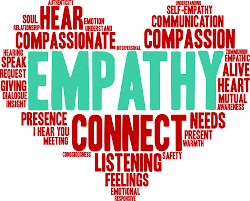The year is winding down, soon to be welcomed in by something new, something hopeful, and something promising. However, that does not diminish the reflections we have had and may continue to have on what 2020 has looked like, though it varies from person to person. What was beginning to look one way in 2020 suddenly took a big swing, and along with that one swing came many other subsequent changes. Some found gratitude in the small things, some struggled with change, and some found themselves grappling with loss. As we continue to navigate this unknown and yet constantly changing space, it’s helpful to show empathy toward ourselves and those around us.
What is empathy?
As Dr. Brené Brown has uncovered through her extensive research on empathy, vulnerability, and risk, empathy is equated with connection and because of the connection, it is effortful. Empathy asks us to step back and take the perspective of another, to listen without judgement, and to communicate with validation that we see what another is feeling. Empathy doesn’t need us to understand, but it does ask us to see and to witness. To witness with our full attention…well, that’s scary. It’s easier to shrink and run away back to what is comfortable, which is why we often resort to sympathy.
What is the difference between sympathy and empathy?
As Brown explains here, sympathy and empathy are often intertwined, but they are very different. Sympathy is comfortable because it allows us to mildly participate. We can understand someone’s problem, we can patch it up, and then we return to how we function. However, the person on the other end may not feel better. Empathy requires experiencing someone’s concern, listening to them, and validating them, which makes it tough. When we use sympathy, we often respond with “but” or “at least.” What if a friend of yours lost their job due to the COVID pandemic? A sympathetic response may have us say “at least you’re still healthy. You can go find another job!” However, an empathetic response might invite us to sit with their real feelings and respond, “I’m so sorry. You must be really scared.” The second one allows for a deeper connection. You see the other person and they will see you in return.
Practicing Empathy
This time of year may be challenging for some and rewarding for others. Being empathetic towards yourself and those you love allows for more kindness, forgiveness, and connection. What are some steps you can take to gets there?
- Mindfully listen: Listen without judgment. To help with this practice, reflect back to the person you are talking to about what you have observed they said, “I heard you say this…” You can acknowledge something without agreeing with it.
- Describe the emotions or thoughts that have been said or unsaid: “It sounds like you feel sad, scared, excited, angry” or “I wonder if you’re feeling or thinking this…” Describing the emotion, or naming it, provides validation and it increases a person’s level of safety to open up further.
- Match vulnerability: Openly express that you have felt this way too to validate their feelings and to increase their feelings of safety. “I also feel___ at times…”
- Responding: “What do you need?” Do they need a solution, or to continue listening? Do they want to do something different together? Showing this response reflects that you care about the action that is most appropriate at this time.
Though these strategies are intended to use when speaking to someone else, exploring what you need internally will expand that empathy and kindness to yourself. Giving yourself empathy will help you extend it to others.
Written By: Alice Zic, MPH, MSW, a Supervisee in Social Work, specializes in supporting individuals and families in healing from trauma, ADHD, emotion regulation, depression, anxiety, grief and loss, Autism Spectrum Disorder, and kinship family dynamics. Additionally, Alice enjoys working with and has a special interest in family gap conflict, issues of acculturation, and navigating multicultural identity. She is bilingual in Bosnian/Croatian/Serbian and is conversational in Mandarin Chinese.
